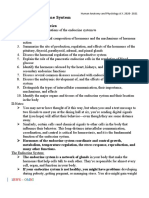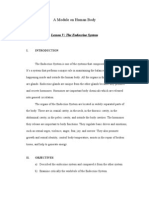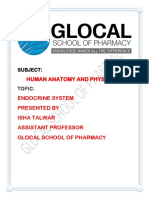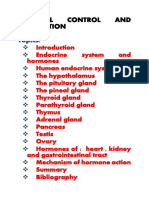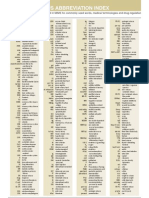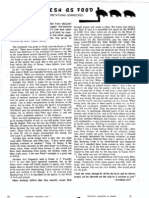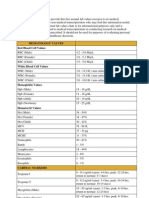Hormones Endocrine Gland: (Clipart Edited From Corel Presentations 8)
Hormones Endocrine Gland: (Clipart Edited From Corel Presentations 8)
Uploaded by
Zheena S. JaroCopyright:
Available Formats
Hormones Endocrine Gland: (Clipart Edited From Corel Presentations 8)
Hormones Endocrine Gland: (Clipart Edited From Corel Presentations 8)
Uploaded by
Zheena S. JaroOriginal Description:
Original Title
Copyright
Available Formats
Share this document
Did you find this document useful?
Is this content inappropriate?
Copyright:
Available Formats
Hormones Endocrine Gland: (Clipart Edited From Corel Presentations 8)
Hormones Endocrine Gland: (Clipart Edited From Corel Presentations 8)
Uploaded by
Zheena S. JaroCopyright:
Available Formats
Lecture
http://biology.clc.uc.edu/courses/bio105/endocrin.htm
Endocrine System
The nervous system sends electrical messages to control and coordinate the
body. The endocrine system has a similar job, but uses chemicals to
communicate. These chemicals are known as hormones. A hormone is a
specific messenger molecule synthesized and secreted by a group of specialized
cells called an endocrine gland.
The major human endocrine glands include:
(clipart edited from Corel Presentations 8)
1. the hypothalamus and pituitary gland
The pituitary gland is called the master gland but it is under the control
of the hypothalamus. Together, they control many other endocrine
functions. They secrete a number of hormones, especially several which
are important to the female menstural cycle, pregnancy, birth, and
lactation (milk production). These include follicle-stimulating
hormone (FSH), which stimulates development and maturation of a
follicle in one of a womans ovaries, and leutinizing hormone (LH),
which causes the bursting of that follicle (= ovulation) and the formation
of a corpus luteum from the remains of the follicle.
There are a number of other hypothalamus and pituitary hormones which
affect various target organs.
Another group of non-sex hormones that many people have heard of is
the endorphins, which belong to the category of chemicals known
as opiates and serve to deaden our pain receptors. Endorphins, which are
chemically related to morphine, are produced in response to pain. The
natural response to rub an injured area, such as a pinched finger, helps to
release endorphins in that area. People who exercise a lot and push their
bodies until it hurts thereby stimulate the production of endorphins. It
is thought that some people who constantly over-exercise and push
themselves too much may actually be addicted to their own endorphins
which that severe exercise regime releases.
2. the thyroid gland
Thyroid hormones regulate metabolism, therefore body temperature
and weight. The thyroid hormones contain iodine, which the thyroid
needs in order to manufacture these hormones. If a person lacks iodine in
his/her diet, the thyroid cannot make the hormones, causing a deficiency.
In response to the bodys feedback loops calling for more thyroid
hormones, the thyroid gland then enlarges to attempt to compensate (The
bodys plan here is if its bigger it can make more, but that doesnt help
if there isnt enough iodine.). This disorder is called goiter.
3. the pancreas
This organ has two functions. It serves as a ducted gland, secreting
digestive enzymes into the small intestine. The pancreas also serves as a
ductless gland in that the islets of
Langerhans secrete insulin and glucagon to regulate the blood sugar
level. The -islet cells secrete glucagon, which tells the liver to take
carbohydrate out of storage to raise a low blood sugar level. The -islet
cells secrete insulin to tell the liver to take excess glucose out of
circulation to lower a blood sugar level thats too high. If a persons
body does not make enough insulin (and/or there is a reduced response
of the target cells in the liver), the blood sugar rises, perhaps out of
control, and we say that the person has diabetes mellitus.
4. the adrenal glands
These sit on top of the kidneys. They consist of two parts, the
outer cortex and the inner medulla. The medulla
secretes epinephrine (= adrenaline) and other similar hormones in
response to stressors such as fright, anger, caffeine, or low blood sugar.
The cortex secretes corticosteroids such as cortisone. Corticosteroids
are well-known as being anti-inflammatory, thus are prescribed for a
number of conditions. However, these are powerful regulators that
should be used with caution
5. the gonads or sex organs
In addition to producing gametes, the female ovaries and
male testes (singular = testis) also secrete hormones. Therefore, these
hormones are called sex hormones. The secretion of sex hormones by
the gonads is controlled by pituitary gland hormones such as FSH and
LH. While both sexes make some of each of the hormones, typically
male testes secrete primarily androgens including testosterone. Female
ovaries make estrogen and progesterone in varying amounts depending
on where in her cycle a woman is. In a pregnant woman, the babys
placenta also secretes hormones to maintain the pregnancy.
6. the pineal gland
This gland is located near the center of the brain in humans, and is
stimulated by nerves from the eyes. In some other animals, the pineal
gland is closer to the skin and directly stimulated by light (some lizards
even have a third eye). The pineal gland secreted melatonin at night
when its dark, thus secretes more in winter when the nights are longer.
Melatonin promotes sleep (makes you feel sleepy). It also affects
reproductive functions by depressing the activity of the gonads.
Additionally, it affects thyroid and adrenal cortex functions. In some
animals, melatonin affects skin pigmentation. Because melatonin
production is affected by the amount of light to which a person is
exposed, this is tied to circadian rhythm (having an activity cycle of
about 24 hours), annual cycles, and biological clock functions.
Assignment: Be able to locate/identify the endocrine glands in the body.
You might also like
- History Taking Form in Gynecology & ObstetricsDocument8 pagesHistory Taking Form in Gynecology & ObstetricsAbdullah Matar86% (7)
- Dasma, Cavite CLUPDocument283 pagesDasma, Cavite CLUPZheena S. Jaro67% (3)
- 3 Point Perspective DrawingDocument7 pages3 Point Perspective DrawingZheena S. JaroNo ratings yet
- Ball Python CareDocument3 pagesBall Python Careapi-237533426No ratings yet
- Lesson Plan For Anatomy and PhysiologyDocument7 pagesLesson Plan For Anatomy and PhysiologyJamie Bagundol100% (1)
- Ms. Cynthia Bea: ProfessorDocument22 pagesMs. Cynthia Bea: ProfessorJohn Cedric Vale CruzNo ratings yet
- V3 Unit 9B - Human Regulation and ReproductionDocument16 pagesV3 Unit 9B - Human Regulation and ReproductionNellNo ratings yet
- Hormones in The BodyDocument9 pagesHormones in The BodySherry SinghNo ratings yet
- HAPL4 - HUMAN ANATOMY and PHYSIOLOGY - MODULE 4 & 5Document47 pagesHAPL4 - HUMAN ANATOMY and PHYSIOLOGY - MODULE 4 & 5welpNo ratings yet
- Anatomy and Physiology WithDocument14 pagesAnatomy and Physiology WithDonita Meña LaroyaNo ratings yet
- Human Anatomy - Module 1 & 2 - Final TermDocument46 pagesHuman Anatomy - Module 1 & 2 - Final TermwelpNo ratings yet
- Grow Taller: © Dr. Laura de Giorgio All Rights ReservedDocument12 pagesGrow Taller: © Dr. Laura de Giorgio All Rights ReservednepplutoNo ratings yet
- Control And Coordination ppt.,module 3.3, class 10, science, by- Renuka Bala Bhakat ,NarwapaharDocument25 pagesControl And Coordination ppt.,module 3.3, class 10, science, by- Renuka Bala Bhakat ,NarwapahardiyassmmalhotraNo ratings yet
- Anatomy and PhysiologyDocument14 pagesAnatomy and PhysiologyDonita Meña LaroyaNo ratings yet
- A Module On Human Body: Lesson V: The Endocrine SystemDocument8 pagesA Module On Human Body: Lesson V: The Endocrine Systemapi-3731377No ratings yet
- Endocrine SystemDocument6 pagesEndocrine SystemChechan AmbaNo ratings yet
- EndocrineDocument15 pagesEndocrineapi-200177496No ratings yet
- Pa Tho Physiology of SepsisDocument5 pagesPa Tho Physiology of SepsisMikee Ann ValdezNo ratings yet
- The Endocrine System: Exocrine GlandsDocument5 pagesThe Endocrine System: Exocrine GlandsahmedfikryNo ratings yet
- Endocrine System PresentationDocument29 pagesEndocrine System PresentationTanayNo ratings yet
- Endocrine SystemDocument58 pagesEndocrine SystemBeBs jai SelasorNo ratings yet
- Endochrine SystemDocument6 pagesEndochrine Systemskitz0frenicoNo ratings yet
- Endocrine SystemDocument14 pagesEndocrine SystemWhyL NificentNo ratings yet
- M3 Endocrine System. UpdatedDocument33 pagesM3 Endocrine System. Updatedlalarela.cindyNo ratings yet
- Endocrine SystemDocument28 pagesEndocrine SystemChen Abendaño AyrosoNo ratings yet
- نسخة Endocrine systemDocument13 pagesنسخة Endocrine systemhuda00lotfyNo ratings yet
- Loi 1Document26 pagesLoi 1nivedita.warrierNo ratings yet
- Illustration of The Endocrine SystemDocument7 pagesIllustration of The Endocrine SystemMohammed MohammedNo ratings yet
- Endocrine SystemDocument40 pagesEndocrine SystemAlmira ZuñigaNo ratings yet
- Chemical Control and IntegrationDocument40 pagesChemical Control and IntegrationdiyNo ratings yet
- The Endocrine SystemDocument6 pagesThe Endocrine SystemAgni ManNo ratings yet
- Med. Surg NotesDocument42 pagesMed. Surg Notesruachhoth8No ratings yet
- Exp 03Document5 pagesExp 03NaitikNo ratings yet
- The Endocrine Glands: The Hypothalamus and Pituitary GlandDocument13 pagesThe Endocrine Glands: The Hypothalamus and Pituitary GlandEd CrownNo ratings yet
- Endocrine System: Anatomy and Physiology of TheDocument5 pagesEndocrine System: Anatomy and Physiology of TheRachel TiangcoNo ratings yet
- ScienceDocument33 pagesScienceI am JNo ratings yet
- UNIT 6. The Endocrine SystemDocument3 pagesUNIT 6. The Endocrine SystemBora OsmaniNo ratings yet
- Endocrine SystemDocument2 pagesEndocrine SystemLawrence GaikwadNo ratings yet
- General Endocrine FunctionsDocument9 pagesGeneral Endocrine FunctionsweseayouphNo ratings yet
- Endocrine SystemDocument24 pagesEndocrine Systempromisefo65No ratings yet
- Chapter 2Document8 pagesChapter 2melanielampera17No ratings yet
- Revision Notes - Endocrine System - 2024Document8 pagesRevision Notes - Endocrine System - 2024mystudylifechloeNo ratings yet
- A.S.Harenee: Biology ProjectDocument16 pagesA.S.Harenee: Biology ProjectHema SubramaniNo ratings yet
- Anatomy of The Endocrine System HypothalamusDocument27 pagesAnatomy of The Endocrine System Hypothalamusdaphnereeze100% (1)
- 1 - The Endocrine System, Pituitary, Hypothalamus (E68-E72)Document52 pages1 - The Endocrine System, Pituitary, Hypothalamus (E68-E72)nourr.kwNo ratings yet
- Endocrine SystemDocument41 pagesEndocrine SystemAtteya Mogote AbdullahNo ratings yet
- Module 1+2Document6 pagesModule 1+2sujaileerosado128No ratings yet
- BioSci LO#2Document16 pagesBioSci LO#2AudzkieNo ratings yet
- Human HormonesDocument54 pagesHuman HormonesKhawaja EshaNo ratings yet
- Adama KanuDocument41 pagesAdama KanuAlie TholleyNo ratings yet
- GroupNo2 Bauyon LabActivityNo12Document6 pagesGroupNo2 Bauyon LabActivityNo12tel krisNo ratings yet
- Endocrine SystemDocument9 pagesEndocrine Systemkevin maheshNo ratings yet
- ScienceDocument4 pagesScienceksdiriksdiriNo ratings yet
- Anatomy of The Endocrine SystemDocument4 pagesAnatomy of The Endocrine SystemJesson CabantogNo ratings yet
- Endocrineglands 140817003157 Phpapp01Document61 pagesEndocrineglands 140817003157 Phpapp01Musfira KhalidNo ratings yet
- Biology Investigation ProjectDocument12 pagesBiology Investigation Projectdr.p.arun372No ratings yet
- Topic 4 Human Physiology1Document28 pagesTopic 4 Human Physiology1Aisha WaqarNo ratings yet
- Endocrine SystemDocument19 pagesEndocrine Systemethel roseNo ratings yet
- Endocrine Glands The Producers of Chemical MessengersDocument10 pagesEndocrine Glands The Producers of Chemical Messengersahmed100% (1)
- Ky 9 KZ OCt YO96 LBRL 0 HH DDocument22 pagesKy 9 KZ OCt YO96 LBRL 0 HH DVenu GopalNo ratings yet
- Endocrine SystemDocument29 pagesEndocrine SystemNiño Adan CadagNo ratings yet
- The Endocrine System and Glands of The Human BodyDocument2 pagesThe Endocrine System and Glands of The Human BodyFungo JasmineNo ratings yet
- A Simple Guide to Pituitary Disorders, Diagnosis, Treatment and Related ConditionsFrom EverandA Simple Guide to Pituitary Disorders, Diagnosis, Treatment and Related ConditionsNo ratings yet
- Thyroid Health: The Thyroid Solution Diet ExposedFrom EverandThyroid Health: The Thyroid Solution Diet ExposedRating: 3 out of 5 stars3/5 (2)
- Ang Konsepto NG BayaniDocument15 pagesAng Konsepto NG BayaniZheena S. Jaro67% (3)
- Biological PsychologyDocument1 pageBiological PsychologyZheena S. JaroNo ratings yet
- Awakenings - Reaction PaperDocument1 pageAwakenings - Reaction PaperZheena S. JaroNo ratings yet
- Edible TallowDocument3 pagesEdible TallowteddydeNo ratings yet
- Truong THPT Chuyen Lam Son - Thanh Hoa Lan 1 - 2018Document84 pagesTruong THPT Chuyen Lam Son - Thanh Hoa Lan 1 - 2018Phan Lê Phương QuyênNo ratings yet
- MIMS Abbreviation IndexDocument1 pageMIMS Abbreviation IndexBrian Harris100% (1)
- What Makes Us Tick? Functional and Neural Mechanisms Oe Interval TimincDocument12 pagesWhat Makes Us Tick? Functional and Neural Mechanisms Oe Interval TimincJuan Fran CoachNo ratings yet
- Desert Habitats: Deserts of The WorldDocument10 pagesDesert Habitats: Deserts of The WorldangeunkacangNo ratings yet
- Electrocardiographic Interpretation of Cardiac Muscle and Coronary Blood Flow AbnormalitiesDocument11 pagesElectrocardiographic Interpretation of Cardiac Muscle and Coronary Blood Flow Abnormalities22194100% (1)
- Liv 12Document1 pageLiv 12ray72roNo ratings yet
- CH 31 ReviewDocument2 pagesCH 31 Reviewremyde07No ratings yet
- Swine's Flesh As FoodDocument4 pagesSwine's Flesh As FoodthetruththewholetruthandnothingbutthetruthNo ratings yet
- WEEK 4 TRANS AnaphyDocument8 pagesWEEK 4 TRANS AnaphygazzyngsalvadorNo ratings yet
- Immunoloy Lippincott Qs 1Document48 pagesImmunoloy Lippincott Qs 1zuft100% (2)
- Bacterial Food IntoxicationDocument46 pagesBacterial Food IntoxicationAnonymous hTivgzixVNNo ratings yet
- 2 NCPDocument2 pages2 NCPJohn CenasNo ratings yet
- AcneDocument4 pagesAcnekingwinston ombionNo ratings yet
- The Cardiovascular SystemDocument23 pagesThe Cardiovascular Systemrobhel740% (2)
- Fever Wound and Sprain NCPDocument5 pagesFever Wound and Sprain NCProren100% (2)
- Hsslive Xii Zoology Lab Notes by Navas 2024Document100 pagesHsslive Xii Zoology Lab Notes by Navas 2024spookyvibee666No ratings yet
- Get The Facts About Tuberculosis DiseaseDocument16 pagesGet The Facts About Tuberculosis Diseasedjprh tbdotsNo ratings yet
- Lesson 31. Lymph NodesDocument24 pagesLesson 31. Lymph NodesLola P100% (1)
- Amazing Healing Power of Kefir: Is Another StoryDocument6 pagesAmazing Healing Power of Kefir: Is Another Storycarangki100% (1)
- Eyelid-1 Anatomy, Physiology and Congenital Anomalies of EyelidsDocument30 pagesEyelid-1 Anatomy, Physiology and Congenital Anomalies of EyelidstuhinsinghNo ratings yet
- Case Study On AsthmaDocument12 pagesCase Study On AsthmaUmamahesh YadavNo ratings yet
- Transplantation PDFDocument18 pagesTransplantation PDFChandan Kumar100% (1)
- Az Üzleti KódokDocument45 pagesAz Üzleti KódokcsillagviragcecNo ratings yet
- Keperwatan DasarDocument14 pagesKeperwatan DasarAdiva LidiyaNo ratings yet
- Volume 12, Issue 2, August 2011 - Influence of Fucoidan in Mucus Thickness of Gastric Mucosa in Patients With Chronic GastritisDocument6 pagesVolume 12, Issue 2, August 2011 - Influence of Fucoidan in Mucus Thickness of Gastric Mucosa in Patients With Chronic Gastritismelz_mocaNo ratings yet
- Normal ValuesDocument5 pagesNormal ValueskulitkulitkoNo ratings yet
- Potassium Intake of The U.S. Population: HighlightsDocument6 pagesPotassium Intake of The U.S. Population: Highlightsglenn padernalNo ratings yet








